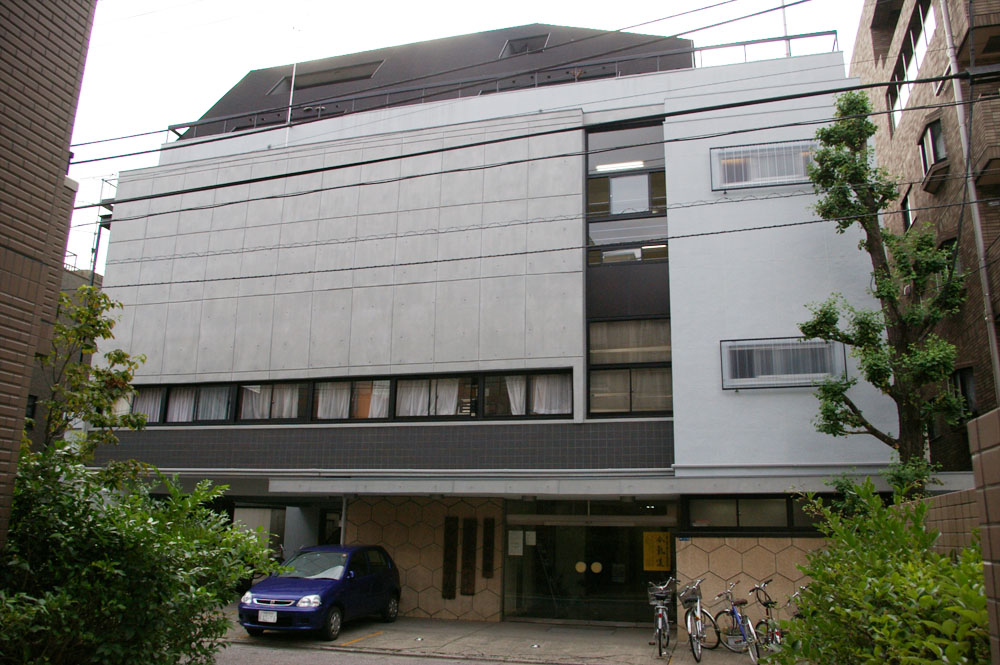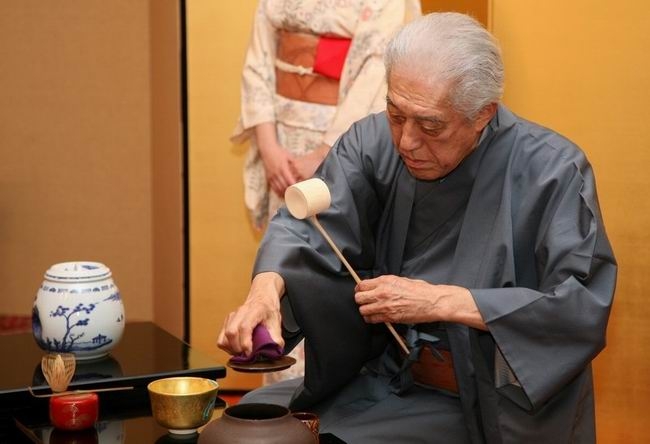|
Aikikai Honbu Dojo
The Aikikai is the original school of Aikido. It is centered on the Aikikai Foundation in Japan, and its figurehead is the Doshu (the family heir of the founder of Aikido). It is represented globally through the International Aikido Federation. Aikikai Foundation The is the original aikido organization. It has been an incorporated entity in Japan since 1940 under the name , then re-registered under the name "Aikikai" after the ban on Aikido practice was lifted by the GHQ in 1948. It is headed by the doshu, the living successor of the founder of aikido. The Aikikai Foundation operates Hombu dojo, which is also named Aikido World Headquarters. It is sometimes called the Aikikai Hombu to distinguish it from the headquarters of later aikido organisations. It is located in Tokyo. The term "Hombu" may sometimes be used loosely to refer to the upper echelons of instructors at Hombu dojo, or to the Aikikai Foundation itself. The Aikikai Foundation also currently manages one sat ... [...More Info...] [...Related Items...] OR: [Wikipedia] [Google] [Baidu] |
Morihei Ueshiba
was a Japanese martial artist and founder of the Japanese martial art, martial art of aikido. He is often referred to as "the founder" or , "Great Teacher". The son of a landowner from Tanabe, Wakayama, Tanabe, Ueshiba studied a number of martial arts in his youth, and served in the Imperial Japanese Army, Japanese Army during the Russo-Japanese War. After being discharged in 1907, he moved to Hokkaido as the head of a pioneer settlement; here he met and studied with Takeda Sōkaku, the headmaster of Daitō-ryū Aiki-jūjutsu. On leaving Hokkaido in 1919, Ueshiba joined the Ōmoto-kyō movement, a Shinto sect, in Ayabe, Kyoto, Ayabe, where he served as a martial arts instructor and opened his first dojo. He accompanied the head of the Ōmoto-kyō group, Onisaburo Deguchi, on an expedition to Mongolia in 1924, where they were captured by Chinese troops and returned to Japan. The following year, he had a profound spiritual experience, stating that, "a golden spirit sprang up f ... [...More Info...] [...Related Items...] OR: [Wikipedia] [Google] [Baidu] |
1989 World Games
The 1989 World Games (), commonly known as Karlsruhe 1989, were the third edition of the World Games, an international multi-sport event. This edition was held in Karlsruhe, West Germany. Titles 112 titles were awarded in 19 sports (5 invitational sports not included). As Invitational sport Medal table The medal tally was as follows. Italy won the most gold medals in this edition; West Germany led in overall medals. Two bronze medals were awarded in the men's karate kata event and in each karate kumite (10) and taekwondo (12) event. Opening Event The opening event was created and organised by the Traumfabrik theater. References External links Official Website of the IWGAat Sports123 (by Internet Archive)Traumfabrik.de {{EventsAt1989WorldGames 1989 World Games World Games The World Games are an international multi-sport event comprising sports and sporting disciplines that are not contested in the Olympic Games. They are usually held every four years, one ye ... [...More Info...] [...Related Items...] OR: [Wikipedia] [Google] [Baidu] |
Shihan
is a Japanese term that is used in many Japanese martial arts as an honorific title for expert or senior instructors. It can be translated as "master instructor". The use of the term is specific to a school or organization, as is the process of becoming a shihan. In aikido, the title ''shihan'' often is granted to teachers when they reach 6th dan. It is sometimes associated with certain rights, such as the right to give out black belt ('' dan'') ranks. However, the title is distinct from the black belt ranking system ( ''dan'i''). See also *Sensei The term "先生", read in Chinese, in Japanese, in Korean, and in Vietnamese, is an honorific used in the Sinosphere. In Japanese, the term literally means "person born before another" or "one who comes before". It is generally used ... References Titles and rank in Japanese martial arts {{Martialart-term-stub ... [...More Info...] [...Related Items...] OR: [Wikipedia] [Google] [Baidu] |
Dōjō
A is a hall or place for immersive learning, experiential learning, or meditation. This is traditionally in the field of martial arts. The term literally means "place of the Way" in Japanese. History The word ''dōjō'' originates from Buddhism. Initially, ''dōjō'' were adjunct to temples and were formal training places for any of the Japanese arts ending in "''-dō''", from the Chinese '' Dao'', meaning "way" or "path". Sometimes meditation halls where Zen Buddhists practice ''zazen'' meditation were called ''dōjō''. The alternative term '' zen-do'' is more specific, and more widely used. European ''Sōtō Zen'' groups affiliated with the International Zen Association prefer to use ''dōjō'' instead of ''zendo'' to describe their meditation halls as did their founding master, Taisen Deshimaru. In Japan, any facility for physical training, including professional wrestling, may be called a ''dōjō''. In the Western world, the term ''dōjō'' (when related to phys ... [...More Info...] [...Related Items...] OR: [Wikipedia] [Google] [Baidu] |
Kisshomaru Ueshiba
was a prominent Japanese master of aikido.Pranin, S. A. (''c.'' 2009)Encyclopedia of Aikido: Ueshiba, Kisshomaru Retrieved on March 1, 2010. He was the son of Morihei Ueshiba, founder of aikido, and became the international leader of aikido after his father's death.Goldsbury, P. (1999)Obituary: Doshu Kisshomaru Ueshiba Retrieved on March 2, 2010. Early life Ueshiba was born on June 27, 1921, in the city of Ayabe, Kyoto Prefecture, Japan.Aikikai Foundation: Doshu chronology Retrieved on February 28, 2010. He was the third son and fourth child of and Hatsu Ueshiba (née Itokawa).Dang, P. T., & Seiser, L. (2006): ''Advanced Aikido'' (p. 3). Tokyo: ... [...More Info...] [...Related Items...] OR: [Wikipedia] [Google] [Baidu] |
Iemoto
is a Japanese term used to refer to the founder or current Grand Master of a certain school of traditional Japanese art. It is used synonymously with the term when it refers to the family or house that the iemoto is head of and represents. The word is also used to describe a system of familial generations in traditional Japanese arts such as tea ceremony (including ), , Noh, calligraphy, traditional Japanese dance, traditional Japanese music, the Japanese art of incense appreciation (), and Japanese martial arts. and Go once used the system as well. The system is characterized by a hierarchical structure and the supreme authority of the , who has inherited the secret traditions of the school from the previous . Titles An may be addressed by the title or , or by the title or . In English, is often translated as "Grand Master". The 's main roles are to lead the school and protect its traditions, to be the final authority on matters concerning the school, to issue ... [...More Info...] [...Related Items...] OR: [Wikipedia] [Google] [Baidu] |
Martial Arts
Martial arts are codified systems and traditions of combat practiced for a number of reasons such as self-defence; military and law enforcement applications; combat sport, competition; physical, mental, and spiritual development; entertainment; and the preservation of a nation's intangible cultural heritage. The concept of martial arts was originally associated with East Asian tradition, but subsequently the term has been applied to practices that originated outside that region. Etymology "Martial arts" is a direct English translation of the Sino-Japanese word (, ). Literally, it refers to "武 martial" and "芸 arts". The term ''martial arts'' was popularized by mainstream popular culture during the 1960s to 1970s, notably by Hong Kong action cinema, Hong Kong martial arts films (most famously those of Bruce Lee) during the so-called "chopsocky" wave of the early 1970s. According to John Clements, the term '':wikt:martial art, martial arts'' itself is derived from an older ... [...More Info...] [...Related Items...] OR: [Wikipedia] [Google] [Baidu] |
Ibaraki Prefecture
is a Prefectures of Japan, prefecture of Japan located in the Kantō region of Honshu. Ibaraki Prefecture has a population of 2,828,086 (1 July 2023) and has a geographic area of . Ibaraki Prefecture borders Fukushima Prefecture to the north, Tochigi Prefecture to the northwest, Saitama Prefecture to the southwest, Chiba Prefecture to the south, and the Pacific Ocean to the east. Mito, Ibaraki, Mito, the capital, is the largest city in Ibaraki Prefecture. Other major cities include Tsukuba, Ibaraki, Tsukuba, Hitachi, Ibaraki, Hitachi, and Hitachinaka, Ibaraki, Hitachinaka. Ibaraki Prefecture is located on Japan's eastern Pacific coast to the northeast of Tokyo, and is part of the Greater Tokyo Area, the most populous metropolitan area in the world. Ibaraki Prefecture features Lake Kasumigaura, the second-largest lake in Japan; the Tone River, Japan's second-longest river and largest drainage basin; and Mount Tsukuba, one of the most famous mountains in Japan. Ibaraki Prefectur ... [...More Info...] [...Related Items...] OR: [Wikipedia] [Google] [Baidu] |
Iwama Dojo
Iwama may refer to: *Iwama, Ibaraki, a former town in Nishiibaraki District, Ibaraki Prefecture, Japan * Iwama dojo, an aikido dojo * Iwama Station, a train station in Kasama, Ibaraki Prefecture, Japan * Iwama style, a style of aikido People with the surname *Kazuo Iwama (other) Kazuo Iwama may refer to: *, president of the Sony Corporation * *, Japanese computer science researcher {{hndis, Iwama, Kazuo ..., multiple people *, Japanese pole vaulter *, Japanese footballer {{disambiguation, surname Japanese-language surnames ... [...More Info...] [...Related Items...] OR: [Wikipedia] [Google] [Baidu] |
Metonym
Metonymy () is a figure of speech in which a concept is referred to by the name of something associated with that thing or concept. For example, the word "wikt:suit, suit" may refer to a person from groups commonly wearing business attire, such as salespeople or attorneys. Etymology The words ''metonymy'' and ''metonym'' come ; , a suffix that names figures of speech, . Background Metonymy and related figures of speech are common in everyday speech and writing. Synecdoche and metalepsis are considered specific types of metonymy. Polysemy, the capacity for a word or phrase to have multiple meanings, sometimes results from relations of metonymy. Both metonymy and metaphor involve the substitution of one term for another. In metaphor, this substitution is based on some specific analogy between two things, whereas in metonymy the substitution is based on some understood association or Contiguity (psychology), contiguity. American literary theorist Kenneth Burke considers metonymy ... [...More Info...] [...Related Items...] OR: [Wikipedia] [Google] [Baidu] |





